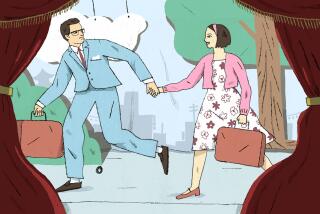Brian Sutton-Smith dies at 90; psychologist turned play into work
With his chums in the windy hills outside Wellington, New Zealand, Brian Sutton-Smith came to know a thing or two about how to have fun.
The friends swooped over an abyss on ropes tied to a pine tree, yelling out the name of the legendary boy who supposedly had plunged to his death far below. They lobbed cow patties at each other, hunted ghosts in an abandoned house, and so exuberantly indulged in play that Sutton-Smith ultimately became one of the world’s foremost thinkers on the subject.
Sutton-Smith, a developmental psychologist who wrote or edited more than 50 books and was among the first academics to treat the study of play as a rigorous discipline, died March 7 in a White River Junction, Vt., nursing home. He was 90.
His death was caused by complications of Alzheimer’s disease, his daughter Emily Sutton-Smith said.
A professor emeritus at the University of Pennsylvania, Sutton-Smith hoped to find a “universal theory” that would tie myriad strands of psychology, evolution science, neurobiology, philosophy and folklore into an overarching explanation of why people play and how they came to do it.
But his thoughts on play kept evolving and play itself never stood still. Still, it had to be studied; for Sutton-Smith, play was nothing less than an existential necessity.
“Play begins as a major feature of mammalian evolution and remains as a major method of becoming reconciled with our present universe,” he wrote. “In this respect, play resembles both sex and religion, two other forms — however temporary or durable — of human salvation in our earthly box.”
Sutton-Smith had a lasting impact on his field, said George Rollie Adams, chief executive and president of the Strong National Museum of Play in Rochester, N.Y.
“For combined diversity and magnitude, together with long-term influence on the thinking of others, Sutton-Smith’s full body of scholarly work stands almost in a category by itself,” Adams said in a statement.
The institution named its 165,000-volume research library for Sutton-Smith after he donated his archives in 2007.
Born in Wellington, New Zealand, on July 15, 1924, he was the son of the local postmaster.
When he became a teacher, he published “Our Street,” a serialized collection of stories he wrote about his childhood exploits. Schoolmasters complained about its liberal use of slang and politicians said that it glorified antisocial behavior.
In 1959, he followed it up with “Smitty Does a Bunk,” a novel for young readers that opens joyously with school letting out for vacation:
“That afternoon everyone had run down the streets from the school crying and yelling and pushing each other and twisting some guys’ heads and pushing and twisting and running and yelling and jumping on their backs and giving them hammerlocks and Chinese burns and punching their arms and giving them chocolate-drops…”
But Sutton-Smith’s focus was on scholarship more than juvenile fiction. He later said that he may have “spent a lifetime studying all this play stuff in an effort to convince my long-dead mother we [he and his brother] were really fine, absolutely normal, even when we were engaging in all this rough stuff.”
Sutton-Smith received his doctorate from the University of New Zealand after completing a 900-page dissertation on unsupervised, rough-and-tumble play. His academic advisors made him delete “the disgusting jokes and rhymes that I discovered elementary school children whispered to each other.”
Immigrating to the United States with his wife, Shirley, Sutton-Smith did research at UC Berkeley and taught at Bowling Green State University in Ohio. From 1967 to 1977, he taught developmental psychology at Teachers College, Columbia University.
He lectured throughout the world and, as a research consultant to the Toy Manufacturers of America, gave frequent interviews.
Asked about trends in the industry at a 1977 toy fair packed with electronic gizmos, he said kids should get out more.
“Apparently, we are planning a world where we live indoors,” he said.
Most of Sutton-Smith’s writing was not aimed at general readers, but in 1974 he and his wife wrote “How to Play With Your Children (And When Not To).” They said such common games as “this little piggy” helped parents bond with their babies and allowed babies to become happier children.
“He was really about letting kids play — whatever direction that took,” Emily Sutton-Smith said.
In addition to his daughter Emily, Sutton-Smith’s survivors include his companion Deborah Thurber; daughters Katherine Moyer, Leslie Sutton-Smith and Mary Sutton-Smith; and 10 grandchildren. His wife died in 2002 and their son Mark in 2013.
Sutton-Smith retired from the University of Pennsylvania in 1990 but worked on play until his last years.
“He was always reading others’ work, watching the world around him, reimagining his philosophy, taking another look at his approach,” Emily said. “I never heard him say ‘I’m done.’”
Twitter: @schawkins
More to Read
Start your day right
Sign up for Essential California for the L.A. Times biggest news, features and recommendations in your inbox six days a week.
You may occasionally receive promotional content from the Los Angeles Times.







